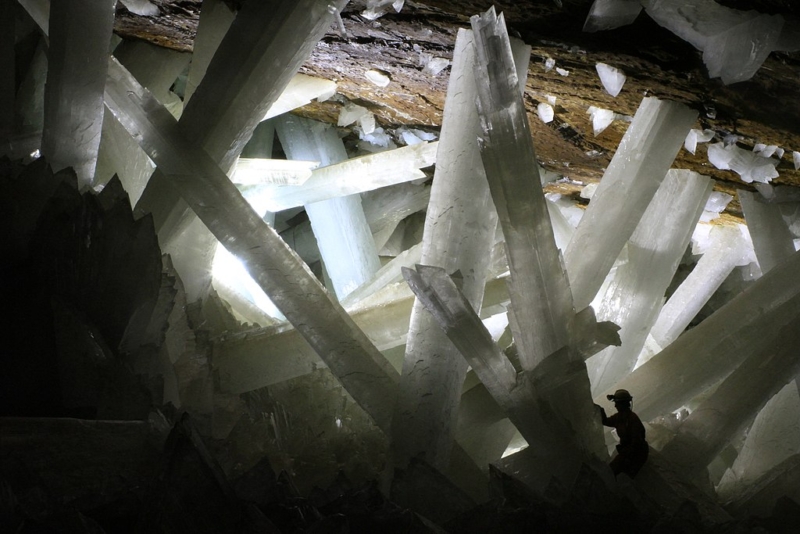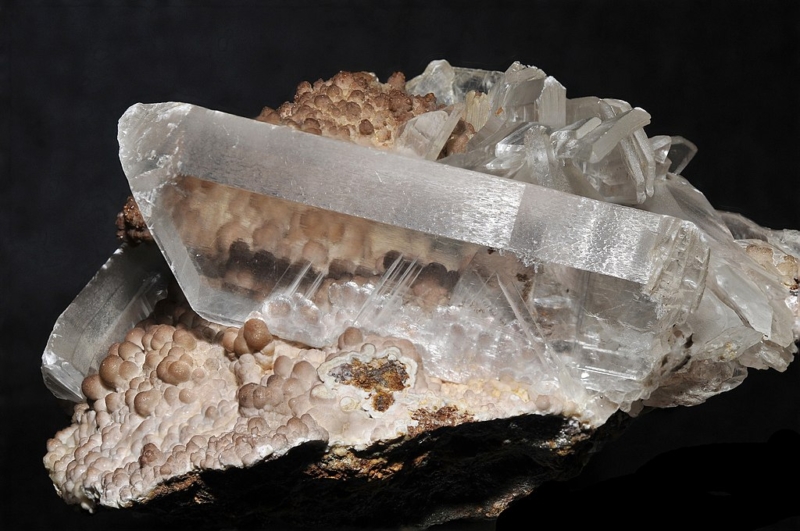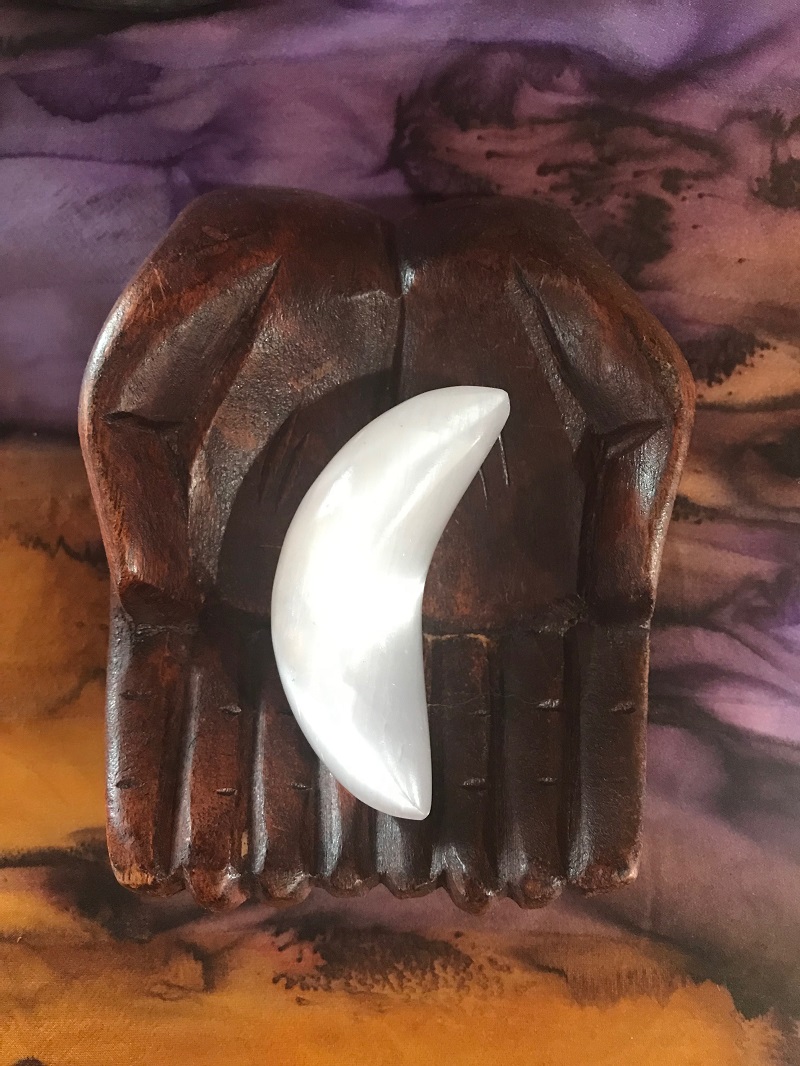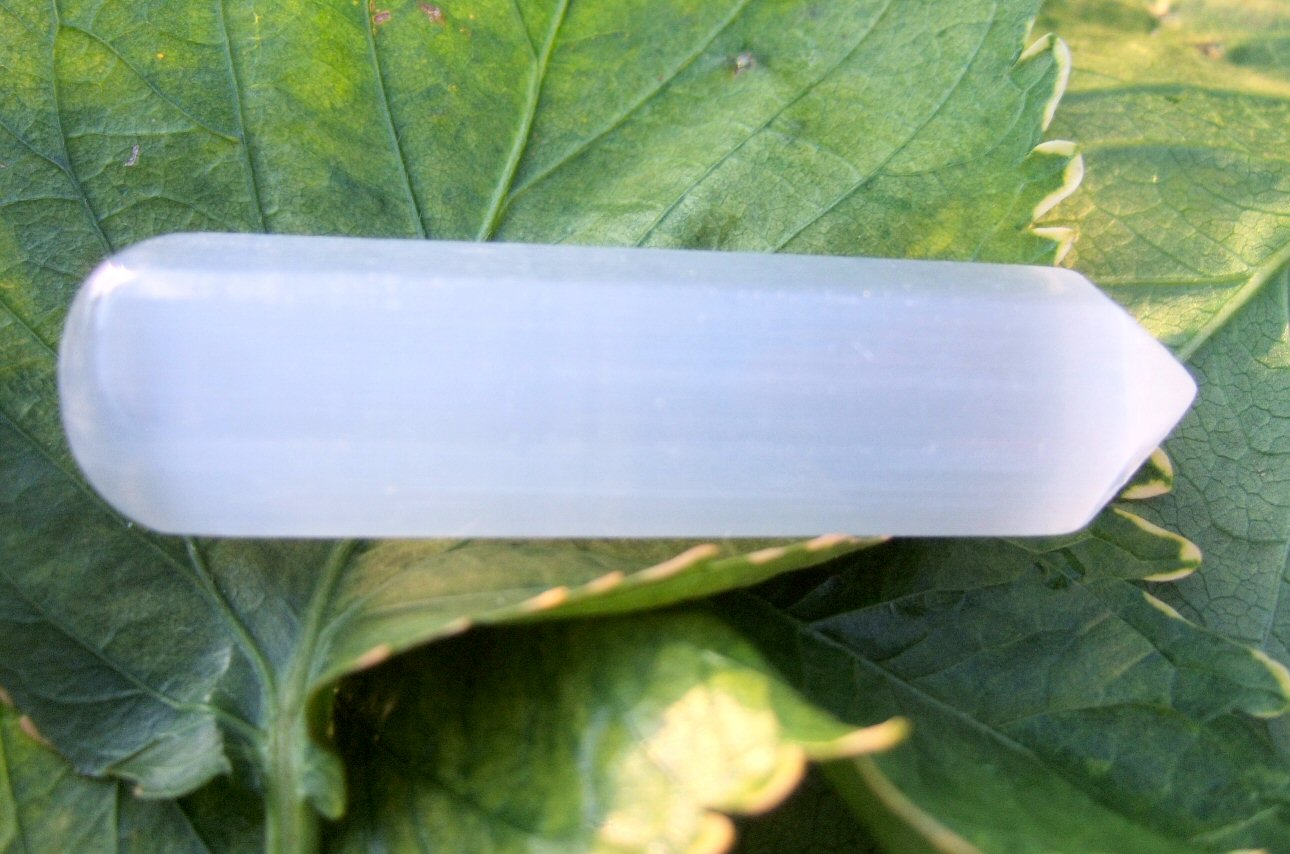Ah, Selenite, named after Selene, the Greek Goddess of the Moon. Let’s lurk into the depths of this ethereal stone and talk about the healing properties, correspondences, and meanings… some geology too! Why not? 
Is it Gypsum, Selenite, or Satin Spar?
As of late, some have gotten very geotechnical with the terminology on this. So please allow me to clarify a bit.
What many have called “Selenite” for years (perhaps as clear back as the 15th century!) is most likely actually properly termed as “Satin Spar” nowadays.
Gypsum
There’s much confusion among these three closely related minerals:
- Selenite
- Satin Spar
- Gypsum
Well, actually they’re ALL a form of gypsum. All three are close siblings in my mind. 😉

Giant gypsum crystals of the Cave of the Crystals in Naica, Mexico. Note person for scale!! Alexander Van Driessche, CC BY 3.0 <https://creativecommons.org/licenses/by/3.0>, via Wikimedia Commons
So technically, the Cave of Crystals in Mexico houses Gypsum crystals, not Selenite. What’s the diff?
Gypsum, Satin Spar and Selenite have the same chemical composition but where they differ is in their crystallization habit. Although those giant crystals in the Cave of Crystals may look like your typical “selenite or satin spar” crystals they’re actually Gypsum crystals which are more fine-grained in their crystal habit. Can you see that above?
Selenite
True-blue Selenite is quite transparent and forms as shiny plates or thin sheets, as seen below. It’s also smooth and not fibrous or pearly looking.

Real-deal Selenite. Parent Géry, CC BY-SA 3.0 <https://creativecommons.org/licenses/by-sa/3.0>, via Wikimedia Commons
Selenite is the most famous of the confusing names, but it’s actually quite rare. And so that means it’s also more pricey. Makes sense, right?
Satin Spar
“Satin spar” is the crystal form most people have commonly called “selenite”. Myself included. 😉 As does much of the rock-hound community to my knowledge. I don’t get too picky about this. I’m down with calling it both Selenite and Satin Spar, as so many have done for centuries.
But if I was selling it… that’s a different story. I’d want to make a clear distinction these days!
Unlike Selenite, Satin Spar is not transparent at all. It’s opaque with a pearly-luminous finish.
Hence, its name; is a nod to its satiny luster.
By the way, there’s a good memory trick for ya: If it looks “satiny” then it’s “Satin Spar”
I often describe it as fibrous (like fiber optics!) with visible parallel crystals running the length of the specimen. Sometimes you’ll see natural towers, which come in a range of sizes from small to quite large.

This is my large Satin Spar tower converted into a lamp. I keep it in either my sacred space and/or my office with a color-changing LED light under it.
Satin Spar also comes in many different cut and polished forms since it’s so easy to work with; such as a heart or a palm stone or shaped into a wand.
A Selenite/Satin Spar massage wand is quite useful tool for working with chakras, the auric field, and sealing up energy (which I teach all about in my course). The wand below is polished and finished with a rainbow fluorite tip. It’s even great for rubbing on the temples to relieve headaches. Good medicine. 
Sacred Space
Selenite is a great addition for creating sacred space. The large lamp (pictured above) hangs out at my house and helps to create a relaxing and serene environment. By the way… a little bit more clarification here: This is a screenshot of a convo that’s relevant to this Satin Spar lamp from my Himalayan Salt Lamp blog post:
(See more under Spiritual Properties below regarding this.) By the way, if you want to see EXACTLY how I laid out my current sacred space, you can get a private video tour here.
Spiritual Properties
Whether Selenite, Satin Spar, or Gypsum crystals…
I feel the energetic properties are all the same, being very closely related. There may be some slight variations depending on the crystal form you choose to work with such as a Gypsum Desert Rose, Selenite window, or a natural Satin Spar wand or tower.
Satin Spar (the most common form) has that luminescent sheen that reminds us of the silvery moon and its feminine, lunar energy inviting you to more easily communicate with your higher chakras and your Higher Self.
Earlier I mentioned how Selenite so reminds me of how fiber optics works. Just like fiber optics, the technology we use to transmit specific info over long distances as pulses of light through strands of thin glass fiber, selenite does the SAME thing via pulses of light when connecting us to our Higher Self!
GEEK ALERT: Just as the Fortress of Solitude did for Superman!!!!! You know I adore these Cosmic Connections. Selenite always gets me thinking of the Fortress of Solitude that Superman went to while growing up and he learned all his stuff and all his knowledge and connected with his Higher Self.
Sound familiar?
(Pretty PLEASE watch this scene above just through minute mark 1:22. I think you’re gonna love it as much as I do!)
All around, Selenite imparts incredible peaceful energy and is a divine communication device. Also, by connecting us to feminine and lunar energy, it helps us to develop our intuitive and telepathic abilities. In fact, it’s one of my favorite crystals to work with to connect us with Moon Energy.
In The Book of Stones, author Robert Simmons suggests the following process to raise your awareness and to contact guides and angels:
- You’ll need at least one Selenite wand, two if possible.
- Lay with your eyes closed in meditation and place one wand point up over your heart chakra.
- If you have a second wand, place it just above your head, touching the top of your head with the point facing down.
- Relax and drop into your meditation while staying open to any messages you might receive either during or after the meditation.
In addition, it’s helpful to have a journal handy so that you can easily take notes on messages, sensations, or experiences received during this activity.
Are the Properties Reliable?
Well, the way I work with Selenite has changed as well.
As of late, I’ve found that I enjoy meditating with Selenite, for making deeper meditation easier. I used to work with Veracruz Amethyst to do that (but feel that energy has shifted as well). I feel the reason for this is that Selenite’s usual mega-impact higher frequency energy has seemed to have lowered its amplitude and dampened down a bit. This is a perfect example of how a crystal isn’t necessarily weaker but instead works extremely well in another capacity.

Selenite Geology
As mentioned above, Selenite or Satin Spar is a crystallized form of Gypsum. Gypsum is a very soft sulfate mineral made of calcium sulfate dihydrate with a pearly luster. While Satin Spar’s technical geologic luster is described as “silky”.
Usually mined in Morocco or Mexico, some varieties are found in Canada. It occurs in caves and limestone cavities. It also occurs in clays, shales, and some sands. Crystals may grow several feet long and may be twinned or even curved. With a Mohs Hardness of two, this mineral is very soft and friable. I recommend you keep it away from water. Not that it’s going to melt away but submerged in water over some days, it will begin to dissolve away and definitely lose its luster.
CAUTION: Although it’s not toxic, due to its friability (brittleness)… tiny shards may break off in water. If you work with gem elixirs, I’ve compiled a comprehensive list of possibly Toxic Stones over here for your reference.
Due to the softer Mohs Harness or make-up of this stone, some artists laser etch Selenite with beautiful designs. Just know that the design may not last forever as it tends to rub off easily. That is unless it’s a display piece that doesn’t really get touched. If you handle and work with the stone often, the design will eventually wear off. That’s just part of the nature of this stone — no big deal, but good to know right? 
Selenite Colors
It can also show up in a few different colors including; gray, brown, or peach. As is the case with all-natural crystals, the different colors stem from different mineral inclusions. Peach Selenite is the most commonly available after white and it’s a beautiful alternative as a candle holder that gives off a nurturing soft orange light.
Selenite Crystal Cave
As I mentioned above, there’s this beautiful, magical Selenite crystal cave in Mexico, called the Cave of Crystals, where these huge Selenite (ahem.. excuse me) GYPSUM humongous crystals have grown. The specific growth environment within this cave (~300 m underground) was ideal for the growth of these giant Gypsum crystals. The largest crystal found is 12 meters (~13 yards) long, 4 meters (~4 yards) thick, and weighs 55 tons.
(Put that in your sacred space and smoke it!)
Although great for crystal growth, it’s not a place we can visit being it’s just too hazardous due to the extreme heat and humidity. It’s quite difficult for even the geologists to go down there, needing a special permit and special conditions. But it’s just so magical to even think about and even know that a place like that exists on Mama Earth!
Does Selenite Need to be Cleansed?
Perhaps you’ve heard or read that “Selenite never needs to be cleansed”. Long story short, nope I don’t agree with that. (OMG… I was talking about this years ago. Step into the time machine with me and let’s head back to 2011 when I used to make YouTube videos with just my hands and no face!)
So, there are some popular crystal books that state that certain crystals never need to be “cleansed” or re-tuned (my preferred word for it). And now that has turned into some stubborn dogma. Not to say this cannot be true for you.
But is it true for you just because someone else said it’s so?
Before we get into it… let me say — if it works for you; keep on TRUCKIN’! Don’t let what I say here to change your mind. See what your intuition tells you. BUT…
I feel that all crystals need to be re-tuned from time to time.
I hear this “no cleansing thing” most often about:
- Selenite
- Kyanite
- Black Tourmaline
- Citrine

Cut and polished Satin Spar/Selenite wand
Again, I feel that there are no crystals or stones that do not require any retuning. I’m just saying — there’s nothing molecularly different about Selenite or the others that would not allow their energies to entrain with other energies. To my knowledge, this “no cleansing thing” did not come from the ancient teachings. I believe it’s a relatively new phenom. So it’s one of those things that makes you go “Hmmmm.” If you want to learn more about my preferred method of retuning crystals —
(think practical and super easy to do) click over to the blog where I share a simple technique: How to Cleanse Your Crystals
Chakras
Selenite is associated with the upper chakras; the Third Eye and Crown Chakras. Working with this stone can help to balance those higher chakras. Simultaneously, the energy moves around when doing this sort of chakra work. While removing stagnant energy or blockages, energy is moving all over the place! It’s best to practice grounding techniques. Or better yet, find a professional Hibiscus Moon Certified Crystal Practitioner near you and schedule a session where you can kick back, relax and replenish.
I hope you’ve enjoyed this blog post all about Selenite today! Please tell me, how do you work with Selenite? Have you found that the energy has shifted? What do you think of my Superman reference? Please share in the comments below. Crystal Blessings,




Hi! LOVE the “Superman” reference! That was always my favorite part of rhe movie as a little girl!
I agree that every stone needs to be re-tuned at some point. Maybe, dare I say, these ideas of stones not needing re-tuning cones from general laziness, or even lack of know-how? Just a thought! Crazier things have been proven true.
Thank you for the great post! As always, you knocked it out of the park!
Hey Ruby! So happy you can relate to the Superman reference. 🙂 I’m normally not into Superheroes but that scene always got me!
Iove this blog. I have all 3types and they do feel the same energy however very much different.
I was always told that they did not need to be cleanse/retuned. However I do my whole house on New & Full moon. Therefore they are being cleansed. When doing a chakra session I do cleanse my true selenite wand. Very informative. Thank you HM. Loved the Superman clip
Karen, good for you! Go your own way. It’s always the right way.
The more I get in to crystals, the more I am confused by them. It makes complete sense to me that selenite requires cleaning; it was counterintuitive that it wouldn’t. So, I am very glad to see that I was not incorrect in my original thought process.
I love crystals! I feel drawn to them intuitively. I feel this way about rocks as well. I’m not sure why, and I try to figure out things, but so often I’m left with more questions.
Always listen to your gut, Amanda. It always knows. 😉 The more learn, the more we realize we don’t know anything! That’s the fun of this adventure. ♥
Omg, love the Superman reference! It totally looks like Selenite in there. Ahem correction… Satin Spar. ????
I know, Kim… it’s like someone had a pretty spot-on vision/premonition of the Naico Mine in Mexico and had to put it in the movie… Superman came out in ’78 and the Giant Crystal Cave wasn’t discovered until April 2000!
Love the Superman ref. I so wanted to visit that place! Can you Imagine! ( as well as look into those eyes, the color wow)
Thank you so much for that, I have known for a while that I was dialing with a gypsum but also chose to keep the name Selenite.
I’m so glad you bought up the changes in the energies of the crystals and stones. I have noticed it with mine as well. Our planets fields are changing so It’s natural.
I have been using a singing bowl of late to reattune the crystals and myself 😀
I use mine for meditation and for the rooms of the house to keep it clear.
I agree with U 100%!
I so appreciate the clarification on selenite.
So I, now know, it’s satin spar that I’m drawn to and have many pieces.
I find my connections with Spirit are unmistakably enhanced & more clear.
I guess I never watched Superman, I’m 62, or perhaps I don’t remember.
Lol.. I watched that clip over and over. Love it. So I’m thinking I wanna watch the movie in its entirety.
????????????????
So just to clarify, when you say that you use selenite to aid with deeper meditation, are you using selenite or satin spar? Just curious ????